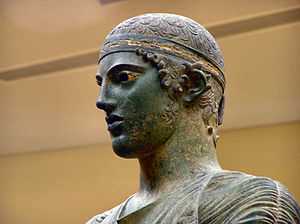Charioteer of Delphi


The Charioteer of Delphi, also known as Heniokhos (Greek: Ηνίοχος, the rein-holder), is one of the best-known statues surviving from Ancient Greece, and is considered one of the finest examples of ancient bronze statues. The life-size (1.8m)[1] statue of a chariot driver was found in 1896 at the Sanctuary of Apollo in Delphi.[2] It is now in the Delphi Archaeological Museum.
Background
The statue was erected at Delphi in 478 or 474 BC,[2] to commemorate the victory of a chariot team in the Pythian Games, which were held at Delphi every four years in honor of Pythean Apollo. It was originally part of a larger group of statuary, including the chariot, four (possibly six) horses and two grooms. Some fragments of the horses were found with the statue. When intact, it must have been one of the most imposing works of statuary in the world.
An inscription on the limestone base of the statue shows that it was dedicated by Polyzalus,[2] the tyrant of Gela, a Greek colony in Sicily, as a tribute to Apollo for helping him win the chariot race. The inscription reads: [P]OLUZALOS MA nETHÊK[EN] ...]ON AES EUONUM APOLL[ON], which is reconstructed to read "Polyzalos dedicated me. ... Make him prosper, honoured Apollo."
The Sicilian cities were very wealthy compared with most of the cities of mainland Greece and their rulers could afford the most magnificent offerings to the gods, also the best horses and drivers. It is unlikely, however, the statue itself comes from Sicily. The name of the sculptor is unknown, but for stylistic reasons it is believed that the statue was cast in Athens. It has certain similarities of detail to the statue known as the Piraeus Apollo, which is known to be of Athenian origin.
Design and completeness
Most bronze statues from ancient times were melted down for their raw materials sometime after casting, but the Charioteer survived because it was buried under a rock-fall at Delphi.[2] The Charioteer is almost intact except that his left forearm and some details on the head are missing including the copper inlays on the lips and most of the silver eye-lashes and headband.[2] The statue is one of the few Greek bronzes to preserve the inlaid glass eyes. Greek bronzes were cast in sections and then assembled. When discovered, the statue was in three pieces—head and upper torso, lower torso, and right arm.
The figure is of a very young man, as is shown by his soft side-curls. Like modern jockeys, chariot racers were chosen for their lightness, but also needed to be tall, so they were frequently teenagers. He is wearing a xystis, the garment which drivers wore while racing. It falls to his ankles and is fastened high at the waist with a plain belt. The two straps that cross high at his upper back prevented the xystis from "ballooning" during the race.
Unusually for this era, the Charioteer is clothed head to foot. Most athletes at this time would have competed, and been depicted nude. The young man would certainly have been of a lower status than his master Polyzalos and Honour and Fleming have speculated that he may have been a household slave that it was not appropriate to depict nude.[2]
Style
Stylistically, the Charioteer is classed as "Early Classical" or "Severe" (see Greek art). The statue is more naturalistic than the kouroi of the Archaic period, but the pose is still very rigid when compared with later works of the Classical period. One departure from the Archaic style is that the head is inclined slightly to one side. The naturalistic rendering of his feet was greatly admired in ancient times.[citation needed] The introverted expression does away with the old 'Archaic smile'.
The Delphos Gown
In about 1907, some ten years after the discovery of the Charioteer, Mariano Fortuny y Madrazo (1871–1949), a Spanish artist-designer based in Venice, created a finely pleated silk dress that he named the Delphos gown after the statue, whose robes it closely resembled.[3][4] These gowns are considered important pieces of early 20th century fashion and art objects in their own right, with one being the only fashion garment in the collection of the Museum of Modern Art, New York.[5]
Gallery
-

Detail of the statue's head, showing the inlaid eyes.
-

Fragments and drawing of Charioteer.
-

Detail of the statue's head and arm.
-

Back view of the Charioteer.
References
- ↑ Janson, H.W. (1995) History of Art. 5th edn. Revised and expanded by Anthony F. Janson. London: Thames & Hudson, p. 142. ISBN 0500237018
- ↑ 2.0 2.1 2.2 2.3 2.4 2.5 Honour, H. and J. Fleming, (2009) A World History of Art. 7th edn. London: Laurence King Publishing, pp. 132-135. ISBN 9781856695848
- ↑ Martin, Richard; Selkirk, Harold Koda ; photographs by Neil (1993). Infra-apparel. New York: Metropolitan Museum of Art. ISBN 9780870996764.
- ↑ Cumming, Valerie; Cunnington, C.W.; Cunnington, P.E. (2010). The dictionary of fashion history. Oxford: Berg. p. 64. ISBN 9781847887382.
- ↑ Antonelli, Paola (2003). Objects of design from the Museum of Modern Art. New York: Museum of Modern Art. ISBN 0870706969.
External links
| Wikimedia Commons has media related to Charioteer of Delphi. |
- Charioteer of Delphi. Ancient Greece.
- Charioteer of Delphi. University of Saskatchewan.
- Michael Scott. "Delphi: The Bellybutton of the Ancient World". 21:42 minutes in. BBC 4. http://www.bbc.co.uk/programmes/b00w4jtx. Retrieved 23 Nov 2010.